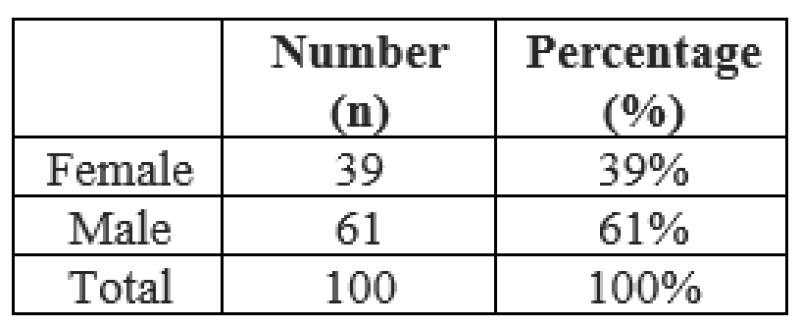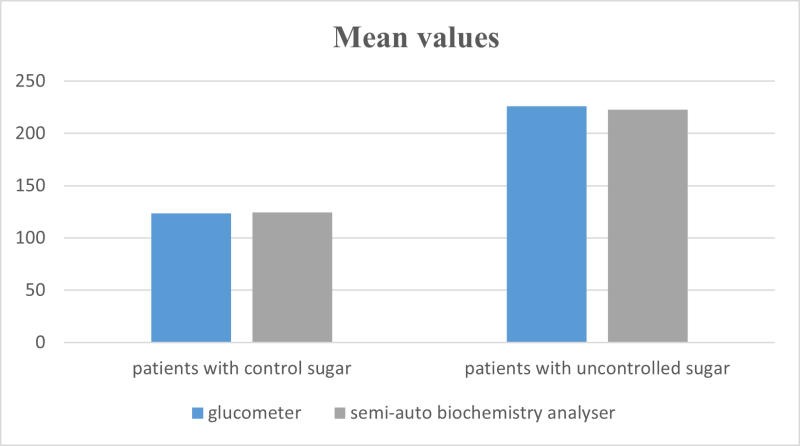Abstract
Introduction:
Diabetes is a prevalent chronic condition affecting individuals of all ages, with type-2 diabetes being the most common form. India ranks second globally in diabetes prevalence, with projections indicating a significant rise in cases. The disease results from insulin deficiency or resistance, leading to elevated blood glucose levels. Glucose, the primary energy source for the body, is regulated by insulin produced by the pancreas. India faces a diabetes epidemic, with a high number of affected individuals and a concerning trend of increasing prevalence.
Material and method:
The study comprises 100 patients, The semi-auto analyser uses the glucose oxide-peroxidase technique to assess blood glucose levels. One capillary blood drop will be simultaneously applied to the glucose meter's strip, which uses an electrochemical sensor to detect the patient's blood sugar.
Result and conclusion:
For diagnosis, follow-up, and emergency situations in both diabetic and non-diabetic individuals, capillary blood glucose assessment via glucometer is a more reliable option than venous plasma glucose estimation.
Keywords
Blood Glucose ,Semi-Auto Biochemistry Analyser, Glucometer
Introduction
Diabetes is a most common condition that affects people of all ages. There are many types of diabetes but type-2 is more common. In diabetes prevalence India is second in the world.[1] Two major groups of diabetes are insulin dependent diabetes mellitus (IDDM type-1) and non-insulin dependent diabetes mellitus (NIDDM type-2). Since glucose is now the most tested parameter, several electrochemical glucose meter systems, including the OneTouch and many others, have been developed. Monitoring blood glucose levels is also advised in case of diabetic ketoacidosis, hyperosmolar state, and hypoglycaemia, even on an hourly basis. Under such circumstances, glucometer monitoring is a more practical, affordable, and efficient approach than laboratory analysis. Thus, it is imperative to compare the outcomes of various blood collection and estimation techniques. While auto analysers are thought to be more accurate and dependable than glucometers, using them is still recommended due to their portability and practicality.[2] Even so, glucose meters are frequently used as a first-line diagnostic tool in homes and hospitals to determine blood glucose levels. Because of this, glucometers are now frequently used in healthcare settings to make critical decisions regarding blood glucose concentration.
MATERIALS AND METHOD
The present study was conducted in the B.N. Patel Institute Of Paramedical & Science college, Anand. All adult male and female participants in the research were chosen from an age range of 30 to 90 years old. Total 2 ml of blood collected by venipuncture and placed in plain clot activator tube and take 1 drop of blood by lancet for glucometer.
RESULT
Table-1 distribution of subjects based on gender

Table-1 suggests that, distribution of subjects based on gender, out of total 100 subjects, 39 (39%) subjects were females and 61 (61%) subjects were males as shown table.

Table-2 Glucose values (both patients with Control sugar levels and Patients with uncontrolled sugar levels) are expressed as Mean ± Standard deviation.

Graph-1 mean value of both patients with control sugar levels and patients with uncontrolled sugar level
Table-2 shows that, the glucose values (both patient with Control sugar and Patients with uncontrolled sugar) are expressed as Mean ± Standard deviation. Patients who have a control sugar, the mean and standard deviation values of glucometer are 123.43 mg/dl±11.63 and semi-auto biochemistry analyser mean (124.33mg/dl) and standard deviation (±9.72). other than these, patients with uncontrolled sugar measured by glucometer, the mean (226.20 mg/dl) and standard deviation (±77.58). and semi-auto biochemistry analyser, the mean (222.96 mg/dl) & standard deviation (±69.39).
DISCUSSION
The purpose of this study was to compare blood glucose readings from semi-auto analysers and glucometers. Estimating blood glucose concentrations is based on two different kinds of samples.1) Capillary whole blood was calculated using a glucometer; 2) Venous blood sample was estimated using a laboratory semi-auto analyser technique.[2] The blood glucose levels were compared using a glucometer and a semi-auto analyser. The results, which are presented in Table No. 2, are given as mean ± standard deviation. Graph 1 displayed the comparison of glucose readings between patients with managed and uncontrolled sugar.[3]
CONCLUSION
Our conclusion was that while glucometers may be used at the patient's bedside in an emergency to monitor blood glucose levels, semi-auto analysers are more accurate at estimating the critical blood sugar levels.
REFERENCES
- Olaniru OB.,Obeta MU., Ibanga, IE., Fiyaktu YB.Bot YS and Goshure JL at all, BLOOD GLUCOSE TESTING: A COMPARATIVE ANALYSIS OF SPECTROPHOTOMETER AND GLUCOMETER IN HOSPITAL BASED MEDICAL LABORATORY IN JOS-NIGERIA DOI: http://dx.doi.org/10.24327/ijrsr.2019.1006.3633
- . Supriya Shete, Humaira Khan, A M Siddiqui, Amol Shinde at all., A comparative study of venous and capillary blood s by semi auto analyser and glucometer. International Journal of Recent Trends in Science and Technology May 2016; 19(1): 46-48 http://www.statperson.com/
- A Comparative Study of Blood Glucose Level Measurement between Glucometer, Semi-Auto Analyzer and Auto-analyser. Ilanchezhian*, Shanmuga Priya, Dr.T. Rajini Samuel, Balaji Rajagopalan


 Amee G. Upadhyay*
Amee G. Upadhyay*
 Janvi Kachhia
Janvi Kachhia



 10.5281/zenodo.10880904
10.5281/zenodo.10880904